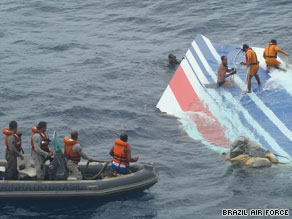
Air France has agreed to replace within days sensors on all of its Airbus A330 and A340 airplanes, parts that are suspected of being involved in last week’s crash, a pilots’ union said Tuesday.
Air France said Saturday that it had begun replacing the sensors throughout its fleet in April. An Air France representative said Tuesday the airline would not comment until after a meeting later in the day between Air France and the SNPL union. Airbus had advised airlines to update the pitot tubes, part of the equipment that monitors speed. The recommendation was a result of technological developments and improvements, an Airbus spokesman said. The change was not mandatory. Investigators in Paris said Saturday that the Air France flight sent 24 automated error messages about four minutes before it crashed. The messages suggest the plane may have been flying too fast or too slow through severe thunderstorms it encountered before the crash, officials said. Mary Schiavo, a former inspector general for the U.S. Department of Transportation, said four minutes “was a very long time” for automated signals to be sent from the plane. Air France 447 disappeared over the Atlantic early June 1. The jet was en route to Paris, France, from the Brazilian city of Rio de Janeiro with 228 passengers and crew aboard. The first bodies to be recovered from the crash returned to land Tuesday, as helicopters landed on the Brazilian archipelago of Fernando de Noronha, according to a CNN reporter on the scene. Two Brazilian helicopters, each able to carry up to eight bodies, took off earlier to rendezvous with the Brazilian navy ship carrying the 24 bodies that have been recovered. Most of the bodies were found Monday floating about 440 kilometers (273 miles) northeast of the Fernando de Noronha archipelago northeast of the Brazilian coast, military officials said. Items found in the same area Saturday were confirmed to have come from the jet, including pieces of the aircraft’s wing section, luggage and a leather briefcase containing an airplane ticket with a reservation code for the doomed flight, Brazilian air force spokesman Jorge Amaral said. The exact location of the crash has not been determined, because ocean currents probably caused the bodies and debris to drift in the days since the crash. Two key pieces of evidence — the flight data and cockpit voice recorders — remain missing and could lie on the ocean floor. Map of Flight 447’s flight path »
Don’t Miss
Official: Debris not from Air France jet
Airbus A330-200 called ultra-modern, safe
Former royal, Riverdance star among plane’s missing
iReport.com: Send photos, videos
The part of the ocean where the debris and bodies have been found ranges from 6,000 to 8,000 meters (about 19,700 to 26,250 feet) deep. The search area covers 200,000 square kilometers (77,220 square miles), an area nearly as big as the country of Romania. Watch CNN’s Karl Penhaul report on more bodies found » Brazilian officials emphasized Monday that finding bodies was their priority. The French are in charge of finding the black boxes, and a submarine was en route as part of that mission. Fourteen aircraft — 12 Brazilian and two French — were participating, along with five Brazilian ships and one French frigate. In Washington, a U.S. defense official said the U.S. Navy will contribute two high-tech acoustic devices to listen for emergency beacons still operating in deep water. The “towed pinger locators,” which help search for emergency beacons on downed aircraft to a maximum depth of 20,000 feet, will be placed aboard two French tugs that are part of the search efforts, the official said. Recovery of bodies and debris is significant not only for families but also for crash investigators, Schiavo said. “Even if they don’t find anything else, they can get some very important clues from the pieces that they do find and from the human remains,” she said Saturday. Watch an explanation of what could have caused the crash » She said investigators would be able to tell whether there was an explosion from possible residue on the bodies or other items. Or, if water is found in the lungs of victims, investigators would know that the plane went down intact, she said.